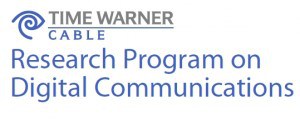Time Warner Cable paid $20,000 for a report that concludes, “policymakers not only need to focus on the oft-stated long-term goal of encouraging Fiber-To-The-Home but also on the more immediate need to bring fiber significantly closer to the customer.”
That declaration was included in one of five essays released this week by Time Warner Cable’s Research Program. When we first wrote about this program in February, we were convinced that the resulting essays would parrot the cable company’s public policy agenda. We were largely right, especially in those that delved into public policy matters. They stayed safely inside the company’s policy boundaries. Even those who focused on technical matters avoided directly challenging the company writing the check.
The cable company earlier announced it would pay $20,000 stipends to essayists that wrote research reports on these questions:
- How are broadband operators coping with the explosive growth in Internet traffic? Will proposed limits on network management practices impede innovation and threaten to undermine consumers’ enjoyment of the Internet?
- How can policymakers harmonize the objectives of preventing anticompetitive tactics and preserving flexibility to engage in beneficial forms of network management?
- Regarding these issues, describe a vision for the architecture of cable broadband networks that promotes and advances innovation for the future of digital communications.
- How might Internet regulations have an impact on underserved or disadvantaged populations?
- Dale N. Hatfield, executive director, Silicon Flatirons Center for Law, Technology and Entrepeneurship, University of Colorado, “The Challenge of Increasing Broadband Capacity.”
- John G. Palfrey, Jr., Henry N., Ess III professor of Law, Harvard Law School, “The Challenge of Developing Effective Public Policy on the Use of Social Media by Youth.”
- Nicole Turner-Lee, vice president and director, Media and Technology Institute, Joint Center for Political and Economic Studies, “The Challenge of Increasing Civic Engagement in the Digital Age.”
- Scott J. Wallsten, vice president for Research and Senior Fellow, Technology Policy Institute, “The Future of Digital Communications Research and Policy.”
- Christopher S. Yoo, professor of Law & Communciations, University of Pennsylvania Law School, “The Challenge of New Patterns in Internet Usage.”
Among the reports were a few that echoed the cable industry’s public policy agenda, particularly Scott Wallsten’s policy essay, “The Future of Digital Communications Research and Policy.” Wallsten is an industry favorite. He works for the Technology Policy Institute, an industry front group funded by AT&T, Comcast, the National Cable & Telecommunications Association, Qwest, Time Warner Cable, T-Mobile, and Verizon.
Wallsten argues worrying about residential broadband service is far less important than delivering broadband improvements to businesses to spur economic growth. Part of the money to do that might come from raising residential broadband prices. Wallsten points out consumers are willing to pay far more than they do today for their broadband accounts — up to $80 a month for today’s typical access speeds. That’s music to an Internet Overcharger’s ears.
Wallsten’s essay hints that broadband expansion to the unserved, and Washington’s focus on broadband competition, might be misplaced if they are looking for the biggest economic bang for the buck. His overall conclusion? Worry about business broadband, not home residential use.
This is hardly new territory for Mr. Wallsten, who in 2007 wrote a piece warning of the perils of flat rate, unlimited use broadband pricing for the Progress & Freedom Foundation and the Heartland Institute, both great friends of large industry players. Only this time, he got a nice chuck of change from Time Warner Cable ratepayers.
More remarkable was Dale Hatfield’s essay, “The Challenge of Increasing Broadband Capacity.” Unlike Mr. Wallsten’s cable industry public policy echo chamber, Hatfield tries to keep things technical, but also safely made sure he didn’t stray too far off Time Warner’s broadband plantation.
Hatfield discusses the challenges of different broadband technologies ranging from twisted-pair copper wiring that delivers DSL to cable’s hybrid coaxial-fiber networks and the latest generation wireless and fiber optic technologies. Hatfield largely calls them as he sees them, noting DSL’s inherent distance limitations and maximum supportable speeds, cable’s potential for last-mile/neighborhood congestion, wireless spectrum inadequacy, and the promises fiber optics can bring to the broadband revolution if costs can be reduced.
Hatfield avoids embarrassing his benefactor too much by spending the least amount of time and space on the benefits fiber brings to the broadband expansion question:
The fourth technology, fiber optic cable, is generally regarded as the “gold standard” in terms of increasing broadband digital access capacity because of its enormous analog bandwidth and its immunity to natural and man-made forms of electrical noise and interference. The actual digital transmission rate delivered to or from a customer depends upon the details of the architecture employed, but the ultimate capacity is limited more by economic factors rather than by the inherent technical constraints on the underlying technology imposed by Shannon’s Law. In this regard, fiber optic cable is often referred to as being “future-proof” because the maximum digital transmission rates are governed more by the electronic equipment attached to the cable rather than by the actual fiber itself. It is future-proof in the sense that the capacity can be increased by upgrading the associated electronic equipment rather than by taking the more expensive step of replacing the fiber itself.
While Time Warner Cable does market itself as having an “Advanced Fiber Network,” it is, in reality using the same technology the cable industry has used for a decade — fiber distribution into individual towns and large neighborhoods, coaxial cable the rest of the way. Hatfield believes that simply isn’t good enough:
[…]Both DSL and cable modem technology benefit from the shorter distances that are associated with a more dense deployment of their access nodes. This suggests the growing need to extend fiber optic cable capacity closer to the customer—either fixed or mobile—to minimize the distance between the customer and the access nodes.
Hatfield’s subtle conclusion is that broadband expansion is ultimately best served by delivering fiber-optic connections straight to the home, something Time Warner Cable has argued against and refused to provide for years, but has now paid $20,000 to put on their website:
[…]Policymakers not only need to focus on the oft-stated long-term goal of encouraging FTTH but also on the more immediate need to bring fiber significantly closer to the customer to support a vastly increased number of access nodes. This is particularly important in the wireless case, where the capacity added through frequency reuse is critical to facilitating wireless competition with the two major suppliers of fixed broadband capacity—the incumbent telephone and cable television companies.


 Subscribe
Subscribe




TW, or any cableco, would only go to FTTH when local cableco competition is
forcing them to do so.
And, big telcos w/DSL are losing share to the cablecos(with coax) now.
So, no reason for TW to spend the $ now.
Correction to above:
“TW, or any cableco, would only go to FTTH when local TELCO competition is
forcing them to do so. “
If you registered for an account here on Stop the Cap!, you can edit your comments at any time. Thanks for sharing them!